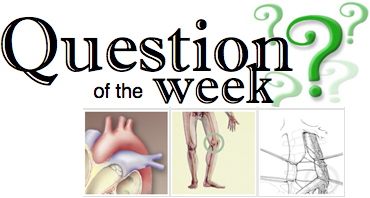When used for the management of acetaminophen overdose, a common adverse effect of intravenous N-acetylcysteine is flushing. What treatment is necessary for flushing resulting from IV NAC?
Please submit your answers to the questions in the “leave a reply” box or click on the “leave a comment” link. Your submission will not immediately post. Answers with a case discussion will post on Friday. If you have any difficulty, please contact the site administrator at arosh@med.wayne.edu. Thank you for participating in Receiving’s Question of the Week.
Filed under: Question of the Week |





Benadryl iv
No treatment is necessary for flushing. It may be dose rate related, so slow down the initial dose. The benefits of giving NAC for outway the discomfort of a little flush. If you are concerned or the patient develops pruritis – give benadryl. Otherwise, continue treatment.
diphenhydramine
According to retrospective, case series, flushing requires no treatment, urticaria should be treated with diphenhydramine, and NAC infusion should be continued in both cases.
IV antihistamine (benadryl 10 to 50mg IV at rate not exceeding 25mg/min)
IV Benadry 25 – 50 mg.
If the patient is experiencing only flushing, nothing is required.
If the patient is also experiencing urticaria, they should be treated with Benadryl.
If the patient also has angioedema, hypotension, or respiratory symptoms, they should be treated with Benadryl, corticosteroids, and bronchodilators for bronchospasm and the IV NAC should be held for 1 hour.
http://www.ncbi.nlm.nih.gov/pubmed/9624310
Management of anaphylactoid reactions to intravenous N-acetylcysteine.
Bailey B, McGuigan MA.
Ann Emerg Med. 1998 Jun;31(6):710-5.
http://www.nejm.org/doi/full/10.1056/NEJMct0708278
Acetylcysteine for Acetaminophen Poisoning
Kennon J. Heard, M.D.
N Engl J Med 2008; 359:285-292
no treatment
Patients who experience only flushing do not require intervention and the infusion can be continued, unless more severe signs develop. Patients who develop urticaria or angioedema should have the infusion stopped and be treated with diphenhydramine (1 mg/kg IV up to 50 mg). The infusion can be restarted once symptoms resolve.
(UPtoDate.com)
Antihistamines and slow the infusion
stop nac. if rxn continues, give benadryl and/or epi as needed for anaphylactoid rxns.
diphenhydramine
The flushing reaction associated with IV N-acetylcysteine administration is believed to be due to an anaphylactoid reaction and just one of the symptoms that may be seen (others include urticaria, angioedema, and bronchoconstriction). Flushing and urticaria are commonly treated with diphenhydramine, if at all (certain attendings with the Poison Center suggest that the only treatment is slowing the infusion rate of IV NAC).
antihistamine
Benadryl
True anaphylactoid reactions with flushing AND uticaria require Antihistamines, if the reaction is isolated flushing only no specific treatment is necessary in a study b published by journal of toxicology 11 patients with flushing there was no difference in the outcome with antihistamines versus no treatment if isolated flushing occurs only.
Trick question! Flushing is benign and there is no treatment necessary. Sometimes calcium is recommended in a dose 3X larger than the NAC. Slowing down the NAC infusion is useful as well. With anaphylactoid reactions and urticaria antihistamines may help. With severe symptoms temporarily stopping IV NAC, and giving albuterol may help. If there are no contraindications, then you can try switching from IV NAC to PO with an anti-emetic agent.
If the only symptom is flushing most patients can tolerate the infusion however if any more sever reactions take place life urticaria or angioedema stop infusion and treat with Diphenhydramine 1mg/kg up to 50mg IV then begin infusion again. There is no strong evidence based medicine that slowing the infusion decrease flushing, or anaphylactoid reactions. if hypotension begins or respiratory symptoms treat according to symptoms as anaphylactoid/allergic reactions
For this reaction to the I.V. NAC it is similar to Red Man Syndrome of Vancomycin just slow down the rate that you are administering. If it were before 8hrs you could use P.O 20% solution diluted at 3:1 in any drink. This is not what we are talking about.